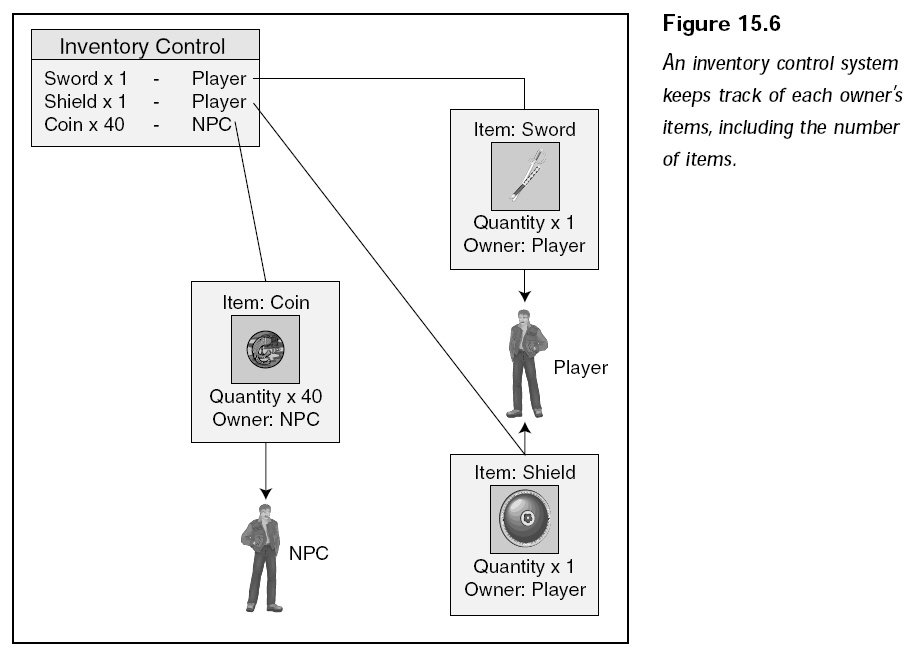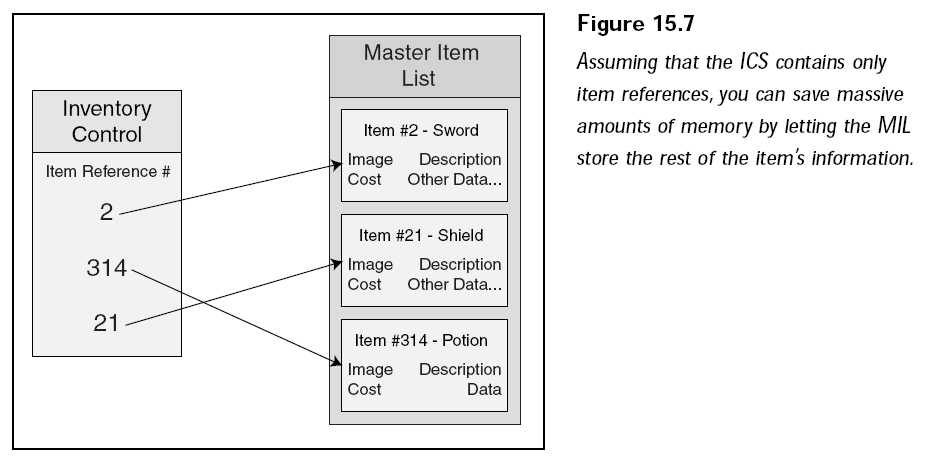本篇是游戲中物件的定義與使用(4)的續(xù)篇。
使用物品清單系統(tǒng)管理物件
物件被分散在四處,玩家們找到這些物件只不過是一個時間問題。對于這種情況,玩家需要運用一種方法去管理物件,包括使用物品清單控制系統(tǒng)(inventory
control system,ICS)來進行分類整理。
請不要誤解,一個ICS并不只適用于玩家,它同樣適用于整個游戲世界。物件可以屬于一張地圖,一個角色,甚至是另一個物件(例如背包,有一些其他的物件在它里面),那就意味著物件需要指定它的所有者(ownership)。除此之外,一個所有者可以擁有一個物件的多個實例(multiple
instance),例如貨幣。
所有者的物件收藏稱之為物件清單列表(inventory
list),任何物件都可以歸屬到這個列表中去(也包括物件的眾多實例)。所有者,物件清單列表,以及數(shù)量之間的關系如下表所示:

ICS和MIL相互協(xié)調(diào)工作,MIL只保存了世界中每個物件惟一的實例,而ICS則使用了物件的眾多實例。每當ICS需要一個物件的信息時,它可以引用MIL。以這種方式,可以僅使用ICS保存MIL中的物件引用編號(如下圖所示),以節(jié)省大量內(nèi)存。

For your game’s maps and
levels, a simple ICS (called a map ICS) consists of only a
list of items and their locations within the map, which is just fine because you
can
place objects throughout—ready for characters to pick them up. The real problem
comes when those characters pick them up and add them to their inventory.
Multiple instances pile up, new items are added, and other items are used or
dropped. Things quickly become a real jumble. Handling a collection of
character’s
objects is the job of a character ICS, which is a little more complicated than
its map
counterpart.
開發(fā)一個地圖ICS
The map ICS tracks items that
are placed within levels, including items that are
contained within other items—a sword contained within a treasure chest, for
example. The type of map you use determines how you position items within the
map. In 3-D maps, you use three coordinates for positioning an item—the X-, Y-,
and Z- coordinates. Because each map is also unique (each part of the world has
different maps), you can track each map’s items in separate files.
You can represent the map ICS
with a structure and a class:
//==================================================================================
// This structure contains map item information list.
//==================================================================================
typedef struct sMapItem
{
long item_index; // MIL item index
long quantity; // quantity of item (ie coins)
float x_pos, y_pos, z_pos; // map coordinates
sMapItem* prev;
sMapItem* next;
long index; // map item index
long owner_index;
sMapItem* parent; // parent of a contained item
sMapItem()
{
memset(this, 0, sizeof(*this));
owner_index = -1;
}
~sMapItem()
{
delete next;
}
} *sMapItemPtr;
//==================================================================================
// This class encapsulate map inventory contrl system.
//==================================================================================
typedef class cMapIcs
{
private:
long m_num_items;
sMapItemPtr m_root_item;
private:
long get_next_long(FILE* fp);
float get_next_float(FILE* fp);
public:
cMapIcs();
~cMapIcs();
bool load(const char* filename);
bool save(const char* filename);
void free();
void add(long item_index, long quantity,
float x_pos, float y_pos, float z_pos,
sMapItemPtr owner_item);
void remove(sMapItemPtr item);
long get_num_items();
sMapItemPtr get_root_item();
sMapItemPtr get_item(long index);
} *cMapIcsPtr;
First, you see the sMapItem
structure, which holds the information for every item in
the map. item_index is the MIL item reference number (which ranges from 0 to
1,023
if you used the MILEdit program), and quantity is the number of item_index (to
allow
things like a horde of coins to be represented as a single object). Then you see
the
item’s map coordinates x_pos, y_pos, and z_pos.
Next comes the prev and next
pointers. You insert them to track a linked list of
sMapItem structures. The next couple of variables, index and owner_index, are
used when
loading and saving the items in a map. Index stores the current index number of
an item in the linked list. If an item is owned by another item, the Owner
variable
holds the index number of the parent object (otherwise, Owner is set to -1).
When
loading (or adding) an object, you set the final variable in sMapItem (parent)
to point
to the actual owner item’s structure. You can see the sMapItem structure link
list concept
illustrated in Figure 15.8.

The sMapItem uses both a
constructor and destructor function called whenever a
structure instance is allocated or reallocated. Both functions ensure that the
linked
list pointers are in check, and whenever a structure is deleted, all subsequent
sMapItem structures in the linked list are deleted as well.
CAUTION
If you’re removing only a single instance of sMapItem from the linked list, you
first have to
set the instance’s Next variable to NULL. Doing so ensures that all subsequent
instances in the
linked list are not deleted as well.
The cMapICS class has two
private functions (get_next_long and get_next_float) used to read
in text and convert it into a long or float value. The cMapICS class also has
eight usable
public functions. Take a closer look at those public functions.